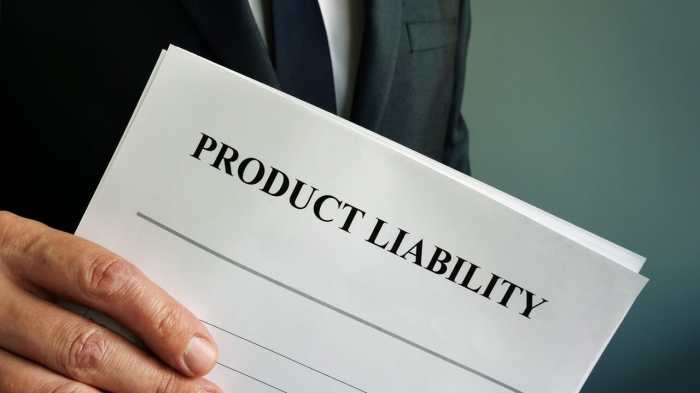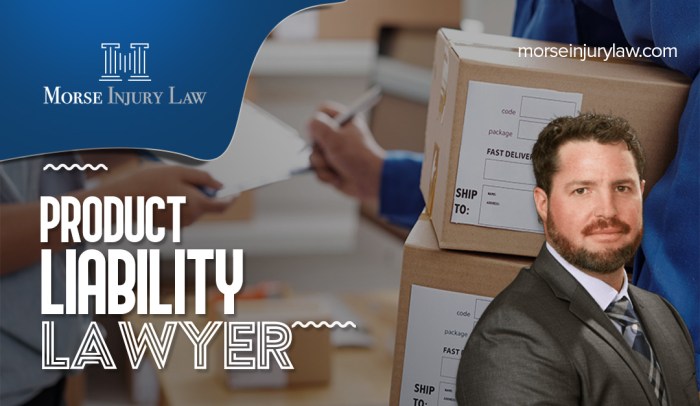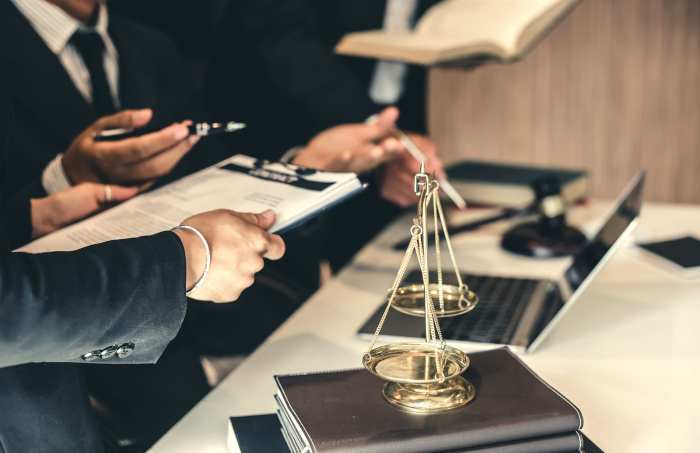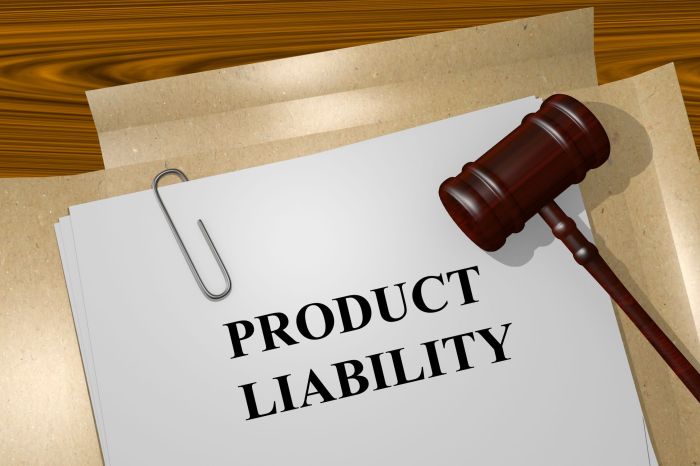Attorney for product liability: Your legal guide to product defects and injuries. When a product causes injury or damage, you need an attorney who knows the law and can help you get the compensation you deserve. We have the experience and expertise to help you hold manufacturers and sellers accountable for their negligence.
If you have been injured by a defective product, you may be entitled to compensation for your injuries, medical expenses, lost wages, and pain and suffering. Our attorneys can help you file a product liability claim and get you the justice you deserve.
Introduction

Product liability refers to the legal responsibility of manufacturers, distributors, suppliers, and retailers for injuries or damages caused by defective products. When a product fails to meet safety standards or contains design flaws, resulting in harm to consumers, the injured parties can seek legal recourse to hold the responsible parties accountable.
An attorney plays a crucial role in product liability cases by representing the injured parties and advocating for their rights. They investigate the case, gather evidence, negotiate with insurance companies, and prepare legal arguments to support their clients’ claims. An experienced product liability attorney can help victims recover compensation for medical expenses, lost wages, pain and suffering, and other damages.
Elements of Product Liability
To establish product liability, several elements must be proven:
- Defective product:The product must have a defect that makes it unreasonably dangerous.
- Causal relationship:The defect must have caused the plaintiff’s injuries or damages.
- Foreseeability:The manufacturer or seller should have reasonably foreseen the potential for harm caused by the defect.
Types of Product Liability Claims
Product liability claims arise when a person is injured or killed due to a defective product. There are several different types of product liability claims, including:
- Design defects:These claims allege that the product was defectively designed, making it unsafe for use.
- Manufacturing defects:These claims allege that the product was defectively manufactured, making it unsafe for use.
- Marketing defects:These claims allege that the product was defectively marketed, making it appear safer than it actually was.
- Failure to warn:These claims allege that the manufacturer failed to warn of the potential dangers of the product.
- Breach of warranty:These claims allege that the manufacturer breached an express or implied warranty about the product.
- Negligence:These claims allege that the manufacturer was negligent in designing, manufacturing, or marketing the product.
- Strict liability:These claims allege that the manufacturer is liable for injuries caused by the product, regardless of fault.
- Res ipsa loquitur:This doctrine allows a plaintiff to prove that a product was defective without having to prove how the defect occurred.
Establishing Liability
Establishing liability in product liability cases is crucial for determining who is responsible for the plaintiff’s injuries or damages. Two primary theories of liability are commonly used: negligence and strict liability.
Proving Negligence
Negligence is the failure to exercise reasonable care, resulting in harm to another person. To prove negligence in a product liability case, the plaintiff must establish four elements:
- Duty of Care:The defendant owed a duty of care to the plaintiff, such as a manufacturer’s duty to produce safe products.
- Breach of Duty:The defendant breached their duty of care by failing to meet the expected standard of care.
- Causation:The defendant’s breach of duty caused the plaintiff’s injuries or damages.
- Damages:The plaintiff suffered compensable damages, such as medical expenses, lost wages, or pain and suffering.
Proving Strict Liability
Strict liability is a legal doctrine that holds manufacturers and sellers liable for injuries caused by their products, regardless of whether they were negligent. Strict liability applies in cases where:
- The product is unreasonably dangerous when used as intended.
- The plaintiff was injured while using the product as intended.
- The product’s defect caused the plaintiff’s injuries.
Defenses to strict liability include:
- The product was altered or modified after it left the manufacturer’s control.
- The plaintiff misused the product.
- The plaintiff assumed the risk of using the product.
Defenses to Product Liability Claims
In addition to negligence and strict liability, several other defenses may be asserted in product liability cases, including:
- Contributory Negligence:The plaintiff’s own negligence contributed to their injuries.
- Assumption of Risk:The plaintiff voluntarily assumed the risk of using the product.
- Statute of Limitations:The plaintiff’s claim is barred by the statute of limitations.
- Product Misuse:The plaintiff used the product in a manner that was not intended or foreseeable.
- Alteration of Product:The product was altered or modified after it left the manufacturer’s control.
Damages in Product Liability Cases
Damages are the monetary compensation awarded to a plaintiff who has been injured by a defective product. The purpose of damages is to make the plaintiff whole again, by compensating them for their losses. There are three main types of damages that can be awarded in product liability cases: compensatory, punitive, and economic.Compensatory damages are intended to compensate the plaintiff for their actual losses.
These damages can be divided into two categories: economic damages and non-economic damages. Economic damages include medical expenses, lost wages, and property damage. Non-economic damages include pain and suffering, emotional distress, and loss of enjoyment of life.Punitive damages are awarded to punish the defendant and deter similar conduct.
Punitive damages are only awarded in cases of egregious misconduct.Economic damages are awarded to compensate the plaintiff for their financial losses. These damages can include lost profits, loss of market share, and damage to reputation.The plaintiff has a duty to mitigate their damages.
This means that the plaintiff must take reasonable steps to minimize their losses. Failure to mitigate damages can reduce the amount of damages awarded.
Statute of Limitations
The statute of limitations establishes a time limit within which legal actions must be filed. For product liability claims, the clock starts ticking when the injury or damage occurs, not when the defect is discovered. In most states, the statute of limitations for product liability claims is two years, but it can vary depending on the jurisdiction and the type of claim.
Exceptions to the Statute of Limitations
There are a few exceptions to the statute of limitations for product liability claims. These include:
- Discovery Rule:In some states, the statute of limitations does not begin to run until the plaintiff discovers or should have discovered the injury or damage caused by the defective product.
- Fraudulent Concealment:If the defendant fraudulently concealed the defect, the statute of limitations may be tolled (paused) until the plaintiff discovers the defect.
- Minority:The statute of limitations may be tolled for minors until they reach the age of majority.
- Insanity:The statute of limitations may be tolled for individuals who are insane or otherwise mentally incompetent.
It is important to note that these exceptions are narrowly construed by the courts, and they do not apply in all cases. If you believe you have a product liability claim, it is important to speak to an attorney as soon as possible to discuss your options.
Insurance Considerations

Product liability insurance is a crucial consideration for businesses that manufacture, distribute, or sell products. It provides coverage against claims alleging injuries or damages caused by defective or dangerous products.
There are various types of insurance policies that cover product liability, including:
- General liability insurance:Covers a wide range of liability claims, including product liability.
- Product liability insurance:Specifically designed to cover claims arising from defective or dangerous products.
- Errors and omissions insurance:Protects professionals, such as architects and engineers, from claims of negligence in product design or manufacturing.
Insurance companies play a significant role in product liability cases:
Role of Insurance Companies
- Provide coverage:Insurance companies provide financial protection to businesses against product liability claims.
- Investigate claims:They investigate product liability claims and determine whether the insured is liable.
- Negotiate settlements:Insurance companies negotiate settlements with claimants to resolve claims.
- Provide legal representation:They provide legal representation to the insured in product liability lawsuits.
Ethical Considerations
Attorneys in product liability cases have a significant ethical responsibility to protect the rights of both consumers and manufacturers. This involves ensuring that the legal process is fair and equitable, that all parties have access to justice, and that the outcome is consistent with the law and the principles of justice.
Protecting the Rights of Consumers
Consumers have the right to be protected from defective products that can cause harm. Attorneys representing consumers in product liability cases must vigorously advocate for their clients’ rights, including the right to compensation for their injuries, the right to have defective products recalled or repaired, and the right to hold manufacturers accountable for their actions.
Protecting the Rights of Manufacturers
Manufacturers also have the right to be treated fairly in product liability cases. Attorneys representing manufacturers must ensure that their clients are not subjected to frivolous or exaggerated claims, that they have the opportunity to present their defense, and that the outcome is based on the evidence and the law.
Case Studies
Landmark product liability cases have significantly shaped product liability law and consumer safety. These cases provide valuable insights into the legal principles and theories involved in holding manufacturers and other parties accountable for defective products.
Defective Design
- Ford Pinto Case (1978):Ford Motor Company was found liable for the deaths of three teenagers in a Pinto that burst into flames after a rear-end collision. The jury determined that Ford knew about the Pinto’s design defect but failed to recall or fix the problem, prioritizing profits over safety.
Manufacturing Defects
- General Motors Side-Saddle Gas Tank Case (1971):General Motors was held liable for a series of fires caused by a defective side-saddle gas tank design in its Chevrolet Corvair. The jury found that GM had failed to properly test and correct the design, resulting in numerous deaths and injuries.
Inadequate Warnings
- Brown v. Kimberly-Clark Corp. (1987):Kimberly-Clark was found liable for failing to provide adequate warnings on its feminine hygiene products about the risk of toxic shock syndrome. The court held that the company had a duty to warn consumers about the potential dangers associated with its products.
These cases demonstrate the importance of holding manufacturers accountable for defective products and ensuring consumer safety. They have led to stricter regulations, increased product testing, and a greater emphasis on consumer protection.
Current Trends in Product Liability Law: Attorney For Product Liability

Product liability law is constantly evolving, with new issues emerging all the time. Two of the most significant trends in recent years are the increasing use of technology and the globalization of the economy.
Technology is having a major impact on product liability law in several ways. First, it is making it easier for consumers to sue manufacturers for defective products. In the past, consumers often had difficulty proving that a product was defective because they did not have access to the necessary information.
Today, however, consumers can easily find information about products online, including reviews from other consumers and technical specifications.
Globalization
The globalization of the economy is also having a major impact on product liability law. In the past, most products were manufactured in the United States. Today, however, many products are manufactured in other countries, which can make it difficult for consumers to sue manufacturers for defective products.
These are just a few of the current trends in product liability law. As technology continues to develop and the economy becomes increasingly globalized, we can expect to see even more changes in this area of law in the years to come.
Choosing an Attorney

Choosing the right attorney for your product liability case is crucial. Here are some factors to consider:
- Experience:Look for an attorney who has handled numerous product liability cases and has a proven track record of success.
- Knowledge:Ensure the attorney is well-versed in product liability laws, regulations, and case precedents.
- Reputation:Inquire about the attorney’s reputation among peers, clients, and legal organizations.
- Communication:Choose an attorney who is responsive, clear in their communication, and keeps you informed about your case’s progress.
- Fees:Understand the attorney’s fee structure and payment arrangements before hiring them.
Finding a Qualified Attorney
To find a qualified attorney, consider the following tips:
- Referrals:Ask friends, family, or other professionals for recommendations.
- Bar Associations:Contact local or state bar associations for a list of attorneys specializing in product liability law.
- Online Directories:Use online directories such as Avvo or Martindale-Hubbell to search for attorneys based on their expertise and location.
- Attend Legal Events:Attend industry events or seminars where you can meet and network with attorneys.
- Interview Potential Attorneys:Schedule consultations with several attorneys to assess their experience, knowledge, and communication skills.
Preparing for Trial
Preparing for a product liability trial requires meticulous attention to detail and a comprehensive understanding of the legal landscape. It involves gathering evidence, preparing expert witnesses, developing a strong case theory, and honing your trial presentation skills.
Role of Experts and Evidence
Experts play a pivotal role in product liability cases, providing specialized knowledge and analysis to support your claims. Common experts include engineers, medical professionals, and economists. They can testify on product design, manufacturing defects, causation, and damages.Physical evidence, such as the defective product itself, packaging, and manufacturing records, is crucial in establishing liability.
Documentary evidence, including invoices, purchase orders, and emails, can provide context and support your case.
Preparing Expert Testimony
To effectively prepare expert testimony, it’s essential to:
- Clearly define the expert’s role and scope of testimony
- Provide them with all relevant materials and information
- Conduct thorough depositions to ensure their understanding and credibility
- Rehearse their testimony to refine their presentation and anticipate cross-examination
Case Theory and Jury Presentation
Developing a strong case theory is the foundation of a successful trial. It should clearly articulate the legal basis for your claims, identify the key issues, and anticipate potential defenses.Your jury presentation should be engaging, persuasive, and supported by compelling evidence.
Use visual aids, such as charts and diagrams, to illustrate complex concepts.
Cross-Examining Opposing Experts
Cross-examining opposing experts requires preparation and skill. Focus on challenging their qualifications, methodology, and conclusions. Use leading questions to expose inconsistencies or weaknesses in their testimony.
Jury Selection
Jury selection is a critical step in a product liability trial. Carefully consider potential jurors’ backgrounds, biases, and experiences to select a fair and impartial panel.
Opening Statements and Closing Arguments
Opening statements and closing arguments provide opportunities to frame the case for the jury and summarize the evidence. Use strong language, compelling stories, and a persuasive tone to capture their attention and sway their opinion.
Trial Procedures
Product liability trials follow a specific set of procedures that determine how the case is presented and resolved. Understanding these procedures can help plaintiffs and defendants prepare for trial and navigate the legal process effectively.
Jury Selection
The first step in a jury trial is jury selection, where potential jurors are questioned to determine their impartiality and qualifications to serve on the jury. Both the plaintiff’s and defendant’s attorneys have the right to challenge potential jurors for cause or through peremptory challenges.
Opening Statements
After the jury is selected, the attorneys for both sides present their opening statements. These statements provide an overview of the case, the parties’ positions, and the evidence that will be presented.
Presentation of Evidence
The next phase of the trial involves the presentation of evidence. The plaintiff’s attorney will present evidence to support their claim, such as expert testimony, product testing results, and witness statements. The defendant’s attorney will then present evidence to refute the plaintiff’s claims or establish defenses.
Closing Arguments, Attorney for product liability
Once all the evidence has been presented, the attorneys for both sides deliver their closing arguments. These arguments summarize the evidence and persuade the jury to reach a verdict in their favor.
Jury Deliberation
After the closing arguments, the jury retires to deliberate and reach a verdict. The jury must reach a unanimous verdict in most cases, meaning all jurors must agree on the outcome.
Verdict
The jury’s verdict is the final decision in the case. The verdict will determine whether the defendant is liable for the plaintiff’s injuries and, if so, the amount of damages the plaintiff is entitled to.
Common Defenses in Product Liability Cases
Defendants in product liability cases may raise various defenses, including:
- The product was not defective.
- The plaintiff’s injuries were not caused by the product.
- The plaintiff misused or altered the product.
- The plaintiff assumed the risk of injury.
- The statute of limitations has expired.
Potential Remedies for Plaintiffs
Plaintiffs who prevail in product liability cases may be entitled to various remedies, including:
- Compensatory damages for economic and non-economic losses
- Punitive damages to punish the defendant and deter future misconduct
- Injunctive relief to prevent the defendant from continuing to sell or distribute the defective product
Role of Expert Witnesses
Expert witnesses play a crucial role in product liability trials. These witnesses provide specialized knowledge and opinions on technical or scientific issues that are beyond the understanding of the average juror. They can testify about the design, manufacturing, and testing of the product, as well as the nature and extent of the plaintiff’s injuries.
Bench Trial vs. Jury Trial
| Characteristic | Bench Trial | Jury Trial |
|---|---|---|
| Decision-maker | Judge | Jury |
| Number of decision-makers | One | Typically 6-12 |
| Jury selection | Not applicable | Extensive process |
| Discovery | More limited | More extensive |
| Burden of proof | Preponderance of the evidence | Clear and convincing evidence |
“In a product liability case, the plaintiff must prove that the product was defective and that the defect caused the plaintiff’s injuries.”
Restatement (Second) of Torts § 402A
Post-Trial Considerations
After a product liability trial, both parties have options for appeal and settlement. The outcome of the trial can have a significant impact on the parties involved, including the defendant’s business, reputation, and financial stability, as well as the plaintiff’s physical, emotional, and financial well-being.
Impact of Product Liability Verdicts
A product liability verdict can have a profound impact on the defendant’s business. A negative verdict can lead to a loss of sales, damage to reputation, and financial instability. In some cases, a large verdict can even force the defendant to close its doors.For the plaintiff, a positive verdict can provide compensation for their injuries and vindication for their suffering.
It can also help to raise awareness of the dangers of the product and prevent others from being harmed.
Insurance Considerations
Insurance plays a significant role in product liability cases. Most businesses carry product liability insurance to protect themselves from the financial consequences of a lawsuit. This insurance can help to cover the costs of defending the lawsuit, as well as any damages that are awarded to the plaintiff.The availability of insurance can also affect the outcome of a product liability trial.
If the defendant has insurance, the plaintiff may be more likely to accept a settlement offer, as they know that they will be able to recover some compensation for their injuries.
Summary
If you have been injured by a defective product, don’t hesitate to contact us today. We offer a free consultation to discuss your case and help you understand your legal options.
Question Bank
What is product liability?
Product liability is the legal responsibility of manufacturers, distributors, and sellers for injuries or damages caused by their products.
What are the different types of product liability claims?
There are three main types of product liability claims: design defects, manufacturing defects, and marketing defects.
What are the elements of a product liability claim?
To succeed in a product liability claim, you must prove that the product was defective, that the defect caused your injuries, and that the defendant was responsible for the defect.
What are the defenses to product liability claims?
There are several defenses to product liability claims, including that the product was not defective, that the defect did not cause your injuries, or that you were contributorily negligent.
What are the damages available in product liability claims?
In a product liability claim, you may be entitled to compensatory damages, punitive damages, and other remedies.